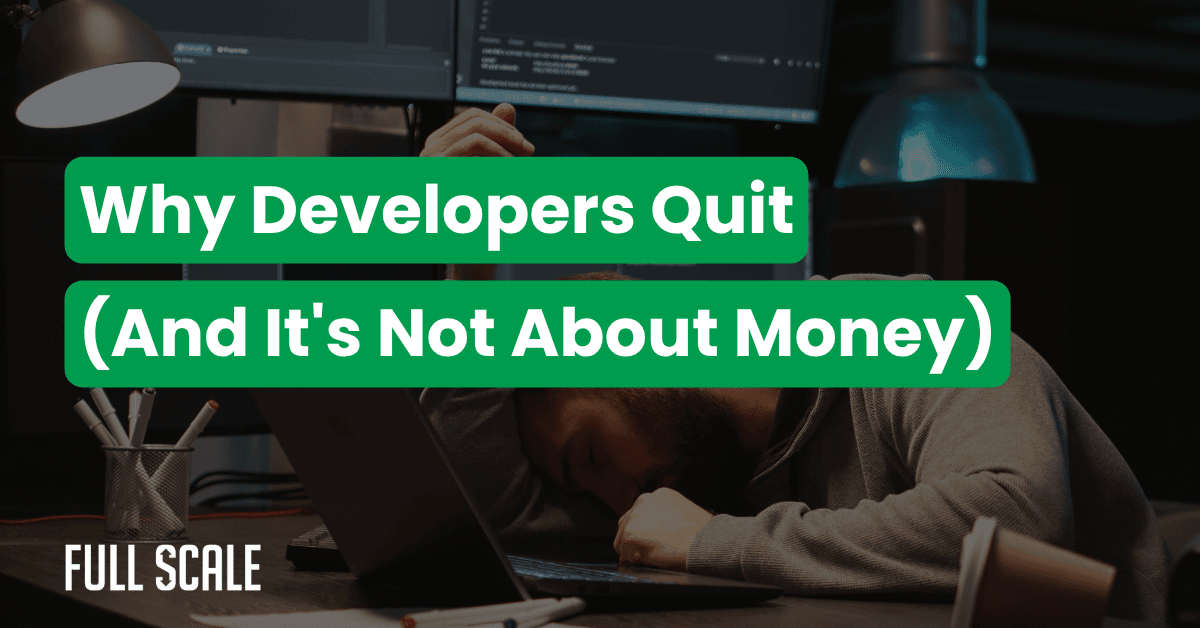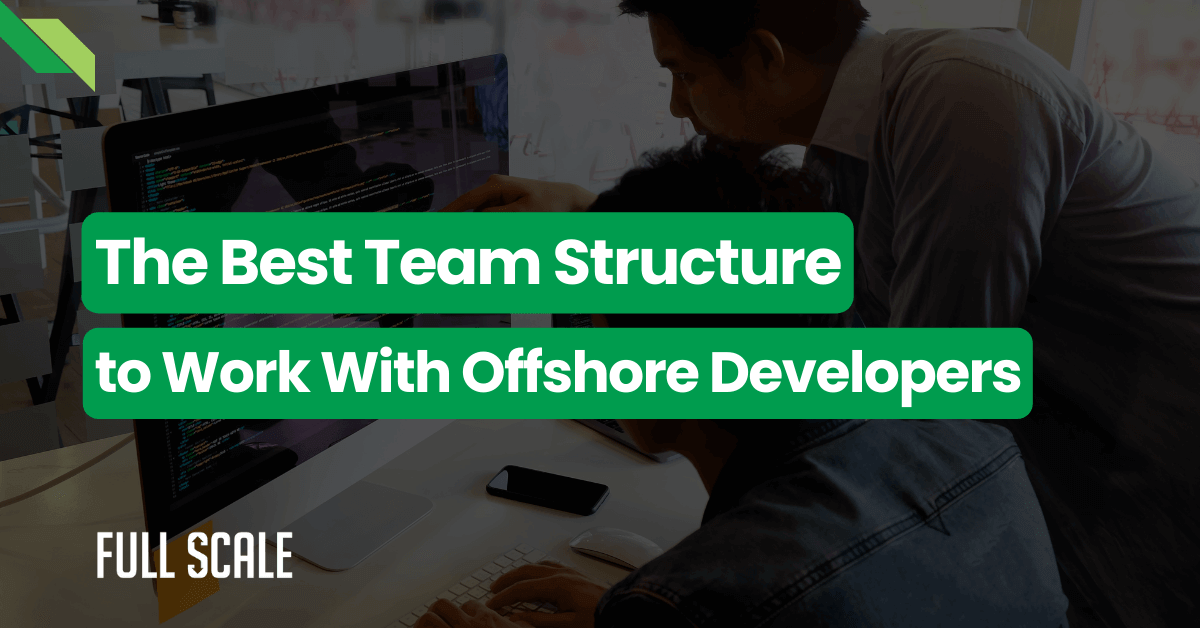Why developers quit?
They can't do meaningful work, not salary issues. Top reasons: (1) legacy system maintenance with no refactoring time, (2) constant meeting interruptions preventing focus, (3) no visibility into code impact, (4) non-technical managers making technical decisions, (5) no learning opportunities. Exit interviews rarely reveal why developers quit because developers avoid burning bridges.
You just lost another senior developer. You countered with a $30K raise. They took it—and quit three months later anyway.
This pattern costs you $200K per departure in recruiting, training, and lost velocity. Why developers quit has nothing to do with salary. Exit interviews won’t tell you the truth.
Your best engineers leave because of five structural problems you’re not seeing. And understanding why developers quit means looking past the polite excuses they give HR.
What You'll Learn in This Article:
- ✓ The real reasons why developers quit (none of them are about money)
- ✓ Why exit interviews lie and what anonymous surveys actually reveal
- ✓ The 5 structural problems causing your best engineers to leave
- ✓ Why counter-offers fail 70% of the time within six months
- ✓ How to build teams where developers actually want to stay
- ✓ The offshore retention advantage most CTOs don't know about
The $500K Problem Every CTO Faces
Your A-player gave notice last week. HR scheduled the exit interview. They’ll say “better opportunity” or “career growth.”
They’re lying. Not maliciously—professionally.
Developers don’t burn bridges in exit interviews. They give polite answers that sound reasonable. They never mention why developers quit.
According to the 2024 Stack Overflow Developer Survey, 62% of developers cite “company culture” as a primary factor in job satisfaction. That’s code for structural problems.
The same survey shows that only 23% list compensation as their top concern. Here’s what actually happens.
Your developer spent six months drowning in technical debt. They requested refactoring time—denied. They suggested better architecture—overruled by someone who hasn’t written code in a decade.
The competitor’s offer gave them permission to escape. Understanding why developers quit requires looking at what happens before they start job searching.

The data reveals a massive gap. Exit interviews capture politeness. Anonymous surveys capture the truth.
Why developers quit becomes clear when you look at what they say anonymously versus what they tell you directly. The real reasons? They’re stuck, bored, overruled, and stagnating.
The 5 Real Reasons Why Developers Quit
After working with 60+ tech companies and managing 300+ developers, we’ve identified five structural problems. None show up in exit interviews.
All are fixable. None gets fixed by throwing money at them. Each one explains why developers quit more than any salary issue ever will.
1. Legacy Code Prison
Your developers spend 80% of their time maintaining systems built in 2014. They request refactoring sprints. You say, “Maybe next quarter.”
Next quarter never comes. Good developers want to build, not babysit.
They joined to create new products. Instead, they’re firefighting in decade-old codebases with no documentation. Every bug fix creates two more bugs.
The 2024 GitLab DevSecOps Report found that 42% of developers spend most of their time on maintenance rather than new development. That’s not a job—it’s a sentence. This is one of the top reasons why developers quit jobs they initially loved.
"You hired a builder and made them a janitor. Then wondered why they left."
What they say in exit interviews: “I want to work with modern technologies.”
What they actually mean: “I’m drowning in your technical debt and you won’t let me fix it.” Legacy code prison alone explains why developers quit, even when you match competitor salaries.
2. Context-Switching Hell
Your senior developer works on five projects simultaneously. They’re in seven meetings daily. They get two-hour blocks—maybe—to actually write code.
This isn’t collaboration. It’s productivity murder.
Senior engineers especially understand why developers quit over meeting overload. They remember what deep work feels like. They know they can’t build anything meaningful in 45-minute increments between standups.
A 2024 study by Qatalog and Cornell University found that it takes an average of 23 minutes to fully return to a task after an interruption. Seven meetings per day means your developers never actually get focused.
Calculate Your Real Cost of Context-Switching
See how much productive time your team loses to constant interruptions
Your Context-Switching Cost:
Based on research showing 23 minutes average refocus time per interruption
Want developers who can actually focus on your project?
Build Your Dedicated Team →What they say: “I want a role with more focus.”
What they mean: “I can’t get anything done here.” This is exactly why developers quit—the constant interruptions make meaningful work impossible.
3. Impact Invisibility
Your developers write code. They never meet end users. They don’t see usage analytics.
They close tickets without knowing if anyone benefits. This kills motivation faster than any salary cut. Why developers quit often comes down to one simple fact: they can’t see if their work matters.
Top engineers want to solve real problems. They want to see their features used. They want to talk to customers about pain points.
You’ve turned them into ticket-closing machines. When developers can’t see the impact, they start looking elsewhere.
The Impact Connection Scale
| Connection Level | Developer Experience | Typical Retention |
|---|---|---|
| Zero Contact | Receives tickets, never sees results | 12-18 months |
| Indirect Feedback | Sees analytics, no user interaction | 24-30 months |
| Direct Connection | Talks to users, shapes product | 48+ months |
This table shows why developers stay or leave. The pattern is clear: connection to impact predicts retention better than compensation. Understanding why developers quit means recognizing that invisible impact drives departures.
What they say: “I want to work on more impactful projects.”
What they mean: “I have no idea if anything I build matters.”
4. Non-Technical Decision Makers
Your VP read an article about microservices. Now you’re refactoring your monolith. Your developers warned against it.
They were overruled. This is why developers quit—being told HOW to solve problems by people who don’t code.
Senior engineers especially can’t tolerate this. They’ve spent 10 years learning their craft. They know the technical constraints.
They understand the tradeoffs. Then someone who hasn’t written code since 2010 makes an architecture decision based on a blog post. You just told them their expertise doesn’t matter.

The data doesn’t lie. Teams with high technical autonomy see 83% lower turnover than teams where non-technical managers make technical decisions. This explains why developers quit teams with competent technical leadership—the leadership isn’t really leading technically.
What they say: “I want more autonomy.”
What they mean: “I’m tired of bad technical decisions from people who don’t understand technology.”
5. Skills Stagnation
Your team uses the same stack they learned in 2018. No time for courses. No budget for conferences.
No experimentation sprints. Why developers quit is partly about their future.
They know their market value depends on current skills. When they’re not learning, they’re falling behind. Their resume isn’t growing—it’s aging.
Every month makes their next job harder to get. You’ve turned their career into a countdown timer. Skills stagnation is one of the hidden reasons why developers quit without warning.
What they say: “I want to work with modern technologies.”
What they mean: “My resume is stale and I’m worried about my future employability.”
Calculate Your Team's Retention Risk
Before you lose another developer, assess your team’s structural problems. This tool assesses your retention risk across all five factors that contribute to developer attrition.
Retention Risk Assessment
Answer 5 questions to discover your team's retention risk level
Your Retention Risk Score
Recommendation:
Ready to build a team with 95% retention?
See How Full Scale Solves This →Why Your Counter-Offer Will Fail
You panic. You offer $30K more. They accept.
Three months later, they quit anyway. This happens 70% of the time, according to research from WorldatWork (2023).
You just paid $7,500 for three months of an already-disengaged developer. Why developers quit after accepting counter-offers is simple: counter-offers address salary, not structural problems.
The competitor’s offer gave them permission to escape the five structural problems you haven’t fixed. Now you have an expensive developer who’s mentally checked out.
They’re still stuck in legacy code. Still context-switching through seven meetings. Still can’t see their impact.
Still getting overruled on technical decisions. Still not learning anything new. You bought three months.
You didn’t solve anything. This is exactly why developers quit, even after getting raises—money never fixed the real problem.
The Counter-Offer Math:
$30,000 raise ÷ 12 months = $2,500/month premium
Average stay after counter-offer = 3-6 months
Result: $7,500-$15,000 to delay the inevitable
I’ve seen this pattern dozens of times at Full Scale. The developer who accepts your counteroffer is still updating their resume.
They’re just doing it from your payroll now. Understanding why developers quit means recognizing that counter-offers fail because they don’t address root causes.
The Developer Departure Timeline
Hover over each stage to see what's really happening
👆 Hover over any stage to see detailed insights
Total Cost: $200K+ in recruiting, training, and lost productivity
Plus 6-12 months of reduced team velocity
This timeline shows the typical pattern. The structural problems start immediately. By month 12, they’re actively looking.
Your counteroffer at month 16 buys you three months. They leave at month 19 anyway. This visual explains why developers quit despite financial incentives.
What This Means for Building Teams
These problems exist everywhere. Local teams. Remote teams.
Offshore teams. The question isn’t geography—it’s structure.
Here’s what most CTOs miss: offshore developers often have better retention than local teams. Full Scale maintains a 95% developer retention rate. Industry average? 60-70% for local teams.
Why? Because good offshore models solve the five structural problems that explain why developers quit.

The Direct Integration Model addresses four of five reasons why developers quit:
- Legacy Code Prison: Dedicated developers can refactor while maintaining features
- Context-Switching Hell: Full-time team members work on one project, not five
- Impact Invisibility: Direct integration means they see the product and talk to your team
- Non-Technical Decisions: They report to your technical leadership, not account managers
Cost Comparison: Local vs. Full Scale Offshore
| Position | U.S. Average Cost | Full Scale Cost | Annual Savings |
|---|---|---|---|
| Junior Developer | $80,000 - $100,000 | $2,400/month ($28,800/year) | $51,200 - $71,200 |
| Mid-Level Developer | $100,000 - $140,000 | $3,900/month ($46,800/year) | $53,200 - $93,200 |
| Senior Developer | $140,000 - $180,000 | $5,200/month ($62,400/year) | $77,600 - $117,600 |
| Team Lead | $160,000 - $200,000 | $6,500/month ($78,000/year) | $82,000 - $122,000 |
Pricing based on Full Scale's current rates. U.S. costs include salary, benefits, taxes, and overhead.
Example: 5-Person Team Savings
2 Senior Devs + 2 Mid-Level + 1 Junior
Save $250,000 - $400,000 annually
Plus 95% retention vs. 60-70% local average = fewer costly replacements
Want to see your specific savings? View detailed pricing or calculate your team’s cost.
How to Actually Keep Good Developers
You can’t fix these problems with pizza Fridays. Here’s what actually works. These aren’t theories—they’re tactics from companies with 90%+ retention rates. They address the real reasons why developers quit.
The 5 Retention Fixes That Actually Work:
1. Dedicate Time for Technical Debt
Minimum 20% of every sprint goes to refactoring. Block every Friday for debt reduction. Let teams self-organize around biggest pain points.
2. Protect Deep Work Time
Three-hour blocks with zero interruptions. No meetings. No Slack. Implement no-meeting mornings or Focus Fridays.
3. Connect Work to Outcomes
Show developers how their code gets used. Monthly demos where developers see features in production. Share user feedback directly.
4. Give Technical Autonomy
Let developers own HOW. You own WHAT. Stop having VPs override engineering decisions because of blog posts.
5. Build Learning Into Work
Rotate people across projects. Budget for courses and conferences. Quarterly innovation sprints where teams try new technologies.
"None of this is easy. All of it is cheaper than replacing a senior developer every 18 months."
The average cost to replace a developer: $200,000 in recruiting, training, and lost productivity. These five fixes? They cost you meeting time and planning discipline.
Do the math. These fixes address the structural reasons why developers quit.
The Retention Reality
Developers don’t quit for money. They quit because they’re stuck maintaining legacy systems. Because they context-switch through seven meetings daily.
Because they can’t see if their work matters. Because non-technical managers overrule their technical decisions. Because they’re not learning anything new.
The salary offer from the competitor is just permission to escape. Now you understand why developers quit—and it has nothing to do with compensation.
You have two choices:
- Keep competing on salary and losing anyway
- Fix the structural problems that make people want to leave
Your ping pong table isn’t a retention strategy. Your unlimited PTO isn’t solving the problem. Your free lunch isn’t keeping your best engineers.
"You can't buy your way out of a structural problem."
The CTOs who figure this out build teams where developers actually want to stay. The CTOs who don’t keep writing counter-offer checks every 18 months. They keep asking why developers quit without looking at their own team structure.
Why Partner With Full Scale
We’ve solved the structural retention problems that explain why developers quit:
- 95% developer retention rate vs. 60-70% industry average
- Direct integration model eliminates middlemen and communication barriers
- Dedicated full-time developers who work as extensions of your team
- Your technical leadership makes decisions, not account managers
- Continuous learning exposure across diverse projects and technologies
- Full team member experience with Slack access and daily standups
- No contractor mindset—developers stay because they’re solving real problems
- Proven with 60+ tech companies and 300+ successful placements
- Month-to-month flexibility without long-term lock-in contracts
- Transparent pricing starting at $2,400/month for junior developers
We don’t just provide developers. We provide the team structure that makes them want to stay. Learn how our model works.
Why developers quit: they can’t do meaningful work, not salary issues. The inability to work on impactful projects drives more departures than compensation. Research shows 71% of developers cite “meaningful work” in anonymous surveys versus only 23% citing compensation.
Developers stay where they can see their code’s real impact. They leave when stuck maintaining legacy systems, context-switching through constant interruptions, or implementing decisions made by non-technical managers. Understanding why developers quit requires looking at structural problems preventing meaningful work, not competitive salary offers.
Keep developers by fixing structural problems that explain why developers quit, not by offering more money. Dedicate a minimum of 20% of sprint time to technical debt reduction. Protect three-hour deep work blocks with zero interruptions.
Connect developers directly to users and product outcomes. Give technical autonomy—let developers own HOW, you own WHAT. Build continuous learning into work through project rotation.
Companies implementing all five fixes see retention rates above 90%, versus a 60-70% industry average.
Senior developers quit when they lose technical autonomy and can’t see meaningful impact. They leave when non-technical managers override architecture decisions. They quit when forced to maintain legacy systems instead of building solutions.
Senior engineers have spent 10+ years building expertise. When that expertise gets ignored or wasted on maintenance work, they leave. The 2024 GitLab DevSecOps Report found 64% cite “lack of technical challenge” as their primary departure reason.
This explains why developers quit even when they’re well-compensated.
Counter-offers rarely work long-term. Research shows 70% of employees who accept counter-offers leave within six months anyway. Counter-offers address the symptom (competitive salary) but not the root problem (structural issues).
You end up paying $30K more annually for a developer who’s already mentally disengaged. The five structural problems still exist. More money doesn’t fix any of these.
This is why developers quit even after getting raises.
Developer retention is often better with offshore teams because good offshore models eliminate the five structural problems explaining why developers quit. Full Scale’s 95% retention rate vs. 60-70% industry average proves this.
Direct integration models provide dedicated developers working on one project (no context-switching). They have clear impact visibility through direct team communication. They report to your technical leadership (autonomy).
The offshore advantage isn’t geographic—it’s structural. The model matters more than location.

Matt Watson is a serial tech entrepreneur who has started four companies and had a nine-figure exit. He was the founder and CTO of VinSolutions, the #1 CRM software used in today’s automotive industry. He has over twenty years of experience working as a tech CTO and building cutting-edge SaaS solutions.
As the CEO of Full Scale, he has helped over 100 tech companies build their software services and development teams. Full Scale specializes in helping tech companies grow by augmenting their in-house teams with software development talent from the Philippines.
Matt hosts Startup Hustle, a top podcast about entrepreneurship with over 6 million downloads. He has a wealth of knowledge about startups and business from his personal experience and from interviewing hundreds of other entrepreneurs.




